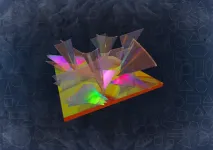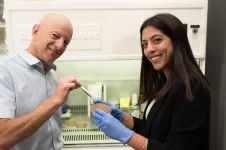(Press-News.org) Researchers at Linköping University, Sweden, have made several discoveries on the functioning mechanisms of the inner hair cells of the ear, which convert sounds into nerve signals that are processed in the brain. The results, presented in the scientific journal Nature Communications, challenge the current picture of the anatomical organisation and workings of the hearing organ, which has prevailed for decades. A deeper understanding of how the hair cells are stimulated by sound is important for such matters as the optimisation of hearing aids and cochlear implants for people with hearing loss.
In order to hear sounds, we must convert sound waves, which are compressions and decompressions of air, into electrical nerve signals that are transmitted to the brain. This conversion takes place in the part of the inner ear known as the cochlea, due to its shape, which is reminiscent of a snail shell. The cochlear duct houses the hearing organ, with many hair cells that are divided into outer and inner hair cells. The outer hair cells amplify sound vibrations, which enables us to hear faint sounds and perceive the various frequencies in human speech better. The inner hair cells convert the sound vibrations into nerve signals. In the current study, the researchers have investigated how the conversion takes place. It is, namely, still unclear how the inner hair cells are stimulated by sound vibrations in order to produce nerve signals.
It has long been known that the outer hair cells are connected to a membrane that rests on top of them. The outer hair cells have hair-like protrusions known as stereocilia that are bent and activated when sound causes the membrane and the hearing organ to vibrate. However, the current view is that the stereocilia of the inner hair cells are not in contact with this membrane, which is known as the tectorial membrane, and that they are stimulated by sounds by a completely different mechanism. It is this model that the new study challenges.
The relationship between the hair cells and the tectorial membrane has been studied in detail by electron microscopy since the 1950s. But it is extremely difficult to investigate how this gelatinous membrane functions, since it shrinks as soon as it is removed from the ear. This makes it extremely difficult to preserve the relationship between the inner hair cells and the tectorial membrane. In addition, this membrane is transparent, and has therefore been essentially invisible. Until now. The LiU researchers noticed that the tectorial membrane reflected green light. This discovery made it possible to visualise the tectorial membrane by microscope.
"We cannot see any gap between the tectorial membrane and the hair cells. In contrast, the stereocilia on both outer and inner hair cells are completely embedded in the tectorial membrane. Our results are incompatible with the generally accepted idea that only the outer hair cells are in contact with the tectorial membrane", says Pierre Hakizimana, principal research engineer at the Department of Biomedical and Clinical Sciences at Linköping University, and principal author of the article.
Pierre Hakizimana and his colleagues have studied the inner ear of guinea pigs, which is very similar to that of humans. When the researchers investigated the relationship between the membrane and the hair cells in more detail, they made a further discovery.
"We found calcium ducts with an appearance that we've never seen before. These calcium ducts span the tectorial membrane and connect to the stereocilia of both the inner and the outer hair cells", says Pierre Hakizimana.
The research group, led by Professor Anders Fridberger, has previously discovered that the tectorial membrane functions as a reservoir for calcium ions, which are needed for the hair cells to convert the sound-evoked vibrations into nerve signals. The researchers followed the motion of the calcium ions in the ducts, and their results suggest that the calcium ions flow through the ducts to the hair cells. This may explain how the hair cells obtain the large amounts of calcium ions needed for their function. The study has also shown that the stereocilia on the inner and outer hair cells are bent by the tectorial membrane in similar ways. The next step of the research will be to understand in more detail how the calcium ions are transported, and identify the protein or proteins that make up the newly discovered calcium ducts.
"Our results allow us to describe a mechanism for how hearing functions, that is incompatible with the model that has been accepted for more than fifty years. The classic illustrations in the textbooks showing the hearing organ and how it functions must be updated. The mathematical models used in research to study hearing should also be updated to include these new findings", says Pierre Hakizimana.
New information about how our hearing functions may in the long term be important for the development of cochlear implants. These are hearing aids that are inserted into the cochlea and which use electrical stimulation to make it possible for children and adults with hearing loss to perceive sounds.
"Cochlear implants are an amazing solution for treating hearing loss, but they can be improved. A deeper understanding of how the inner hair cells are stimulated by sounds is important to optimise how cochlear implants stimulate the auditory nerve", says Pierre Hakizimana.
INFORMATION:
The study has received financial support from the Tysta Skolan Foundation, the Swedish Research Council, and the National Institutes of Health in the US.
The article: "Inner hair cell stereocilia are embedded in the tectorial membrane", Pierre Hakizimana and Anders Fridberger, (2021), Nature Communications, published online on May 10, 2021, doi: 10.1038/s41467-021-22870-1
https://www.nature.com/articles/s41467-021-22870-1
In 1884, Edwin Abbott wrote the novel Flatland: A Romance in Many Dimensions as a satire of Victorian hierarchy. He imagined a world that existed only in two dimensions, where the beings are 2D geometric figures. The physics of such a world is somewhat akin to that of modern 2D materials, such as graphene and transition metal dichalcogenides, which include tungsten disulfide (WS2), tungsten diselenide (WSe2), molybdenum disulfide (MoS2) and molybdenum diselenide (MoSe2).
Modern 2D materials consist of single-atom layers, where electrons can move ...
UK landowners and conservationists welcome wider-spread use of Gene Conservation Units (GCUs) to help protect some of the rarest plants and insects, research at the University of York has shown.
In particular the Great Yellow Bumblebee and the Mountain Ringlet Butterfly, which are at risk of further population decline, would benefit from Gene Conservation Units, currently only employed for forest trees and agricultural species or their relatives.
Genetic diversity in these species is essential if they are to adapt to new, and often challenging, environmental conditions. Gene Conservation Units are areas of land managed to allow the recovery of species, and maintain evolutionary processes to enable them to adapt to environmental change.
For tree species, ...
FRANKFURT. When the SARS-CoV-2 virus mutates, this initially only means that there is a change in its genetic blueprint. The mutation may lead, for example, to an amino acid being exchanged at a particular site in a viral protein. In order to quickly assess the effect of this change, a three-dimensional image of the viral protein is extremely helpful. This is because it shows whether the switch in amino acid has consequences for the function of the protein - or for the interaction with a potential drug or antibody.
Researchers at Goethe University Frankfurt and TU Darmstadt began networking internationally from the very start of the pandemic. Their goal: to describe the three-dimensional structures ...
Thousands of sharks have been illegally caught in a Marine Protected Area (MPA) in the Indian Ocean, new research shows.
The MPA was created in 2010 around the Chagos Archipelago, also known as the British Indian Ocean Territory (BIOT), banning all fishing there.
The new study examined information on illegal fishing in the MPA - a vast (640,000 km²/250,000 mi2) area containing pristine and remote reefs.
Enforcement data suggests more than 14,000 sharks were caught in the MPA from 2010-20, but discussions with fishers in the region suggest the true number was "considerably ...
BEER-SHEVA, Israel May 10, 2021 - Researchers from Ben-Gurion University (BGU), together with American and German colleagues, have developed new "molecular tweezers" to combat antibiotic-resistant bacteria. Their recently announced findings were published in Cell Chemical Biology.
For years, medical professionals have struggled with bacterial infections becoming increasingly resistant to antibiotics. These molecular tweezers may be the key to battling one of greatest public health issues of the 21st century.
"Our discovery prevents infection without building up antibiotic resistance, and it might even be preferable to develop treatments based on molecular tweezers rather than antibiotics," said BGU Department of Chemistry Prof. Raz Jelinek.
The research team, led ...
Bamboo cricket bats are stronger, offer a better 'sweet spot' and deliver more energy to the ball than those made from traditional willow, tests conducted by the University of Cambridge show. Bamboo could, the study argues, help cricket to expand faster in poorer parts of the world and make the sport more environmentally friendly.
"The sound of leather on willow" may have delighted cricket lovers for generations but the sport should now consider making the blades of its bats with bamboo, say researchers from Cambridge's Centre for Natural Material Innovation. ...
A group of UK academics are calling for targets for mental health in order to meet the healthcare challenges of the next decade.
Published today in Journal of Mental Health researchers set out four overarching goals that will speed up implementation of mental health research and give a clear direction for researchers and funders to focus their efforts when it comes to better understanding the treatment of mental health.
The treatment of mental illness currently brings substantial costs to not only the NHS, but also to the individual and wider society, and the need for innovation to promote good mental health has never ...
New research being presented at the European Congress on Obesity (ECO) held online this year, suggests that among girls a low body mass index (BMI) during childhood indicates a higher risk of developing anorexia nervosa as young adults, whereas a high BMI or overweight in childhood indicates a higher risk of bulimia nervosa.
"By examining the records of thousands of girls over their lifetime in national health registers, we have discovered early warning profiles that could signal girls at risk for anorexia nervosa and bulimia nervosa", says lead author Dr Britt Wang Jensen ...
New research being presented at The European Congress on Obesity (ECO) held online this year, suggests that a measure of body shape should be used alongside body mass index (BMI) to help determine the risk of obesity-related cancers.
BMI is a simple way of measuring body fat from the weight and height of a person. But its reliability is often criticised, because it does not distinguish fat from muscle, or take into account where body fat is stored or an individual's sex or age. Similarly, waist circumference takes into account belly fat, which is linked to several health risks ...
Obesity increases the risk of developing 10 of the most common cancers, regardless of how it is measured, according to a study of more than 400,000 adults in the UK, being presented at The European Congress on Obesity (ECO) held online this year, with central fatness (larger waist and hips) and general obesity (body mass index [BMI] and body fat percentage) associated with similar estimates of cancer risk.
The results suggest that BMI is an adequate measure of cancer risk from excess weight, and there is no advantage in using more complicated or expensive measures such as waist circumference or body fat percentage.
It is well known that being overweight or obese is linked to an elevated risk of some cancers and premature ...






